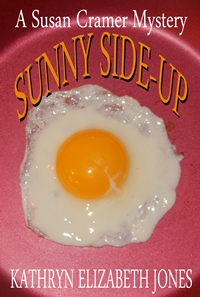The Secret of the Old Clock…The Bungalow Mystery…The Mystery of Lilac Inn…
I was twelve-years-old when I began reading Nancy Drew mysteries by Carolyn Keene. Nancy not only drew me in to her stories, making me feel like a part of them, she made me feel like one of the sleuths. And if I solved the mystery before Nancy or one of her friends, I felt especially smart.
As an adult, I enjoy writing novels and stories with elements of mystery in them. In 2002, I published my first novel, “A River of Stones.” This book, though not specifically a mystery novel, tells, as part of the story, the understood wanderings of an old man whom every child in the neighborhood knows is a vampire. The main character, Samantha, gets her very best friends to wear crosses around their necks and homespun garlic next to their skin. Of course, the vampire isn’t really a vampire, just like Mr. Green, Samantha’s other old and scary neighbor, isn’t a living scarecrow, though he dressed and moved like one on Halloween.
My short stories usually flicker with some mystery in them as well: In the story, “The Awakening of George Mahooney,” for example, we see the main character, George, awaken from sleep and go about his day as usual. He sits on the rocker and thinks about his life and how old he has become. In the backyard, he regrets he no longer has the strength to pick the weeds. In the kitchen his wife is humming a familiar tune as she cooks his breakfast. George wishes he could be happy, but he is too old. When his wife calls the doctor he is suddenly worried. Is she sick? But George quickly discovers it isn’t his wife he should be worrying about at all—he is the one who’s dead.
I love weaving secrets. I love reading to students those parts of my work that keep them guessing. Is that man really a vampire? That sure looks like a coffin in his basement. But why does a light go on when it’s opened? Why isn’t it lined with red, shiny material?
Because the coffin is really a meat freezer.
Why don’t the flies like George Mahooney anymore? Why aren’t they bugging him in the yard? Why aren’t they landing on him? Why doesn’t he have to swat them every other second?
Because the few that have entered the house have already found his body and George is no longer in it.
More recently, I have written two cozy mystery books, both with the sleuth Susan Cramer. In the first, (Scrambled) Susan has just left her husband hoping for a better life, in the second, (Sunny Side-Up) she has finally taken that long awaited cruise. There’s only one problem in both scenarios. Death.
When it comes to writing a great mystery, there are many elements that have to be kept in check; namely, the plot, the clues, the characters, the setting…
But in every book there should be an element of mystery, yes, even if you’re writing a romance. For the reader should be guessing who the girl ends up with or what caused the boy to actually leave her in the first place.
Yes, until the very end.
Contact Kathryn at: http://www.ariverofstones.com or visit her on her Facebook author page: http: www.facebook.com/kathrynelizabethjones.author

I actually did that with my latest manuscript!
Meat freezer in his basement – I can see kids’ imaginations turning that into a coffin.
The scene in my book with the freezer/coffin actually happened to me! :)
Love this! You’re absolutely right: keep the reader wondering. I think kids especially love mysteries. If you think about it, so many things are a mystery to them, with potential for magic and non-rational explanations. When there is a rational explanation, I think it’s reassuring. I grew up on Nancy Drew and Scooby. I loved them!
Thank you, K.B.
I don’t put a lot of mystery in my books, but I did love Nancy Drew when I was younger. I still have the books, which were first editions.
Diane, What’s not to like about Nancy :) I also collect Nancy Drew, though I don’t have the first editions.
Really nice post. Coincidentally, I read this just before:
http://www.advicetowriters.com/home/2014/10/16/all-writers-are-mystery-writers.html
So cool! You know what they say…inspiration is just floating around…Thanks for reading.
Great post! I like having a bit of mystery in the books I read & write too! :)
Thanks! Jemi, What do you write?
I LOVE a bit (or a lot) of mystery in every story. I try to wiggle in elements of shock or surprise where I can in my short stories.
Great article.
What do you write, Teresa?